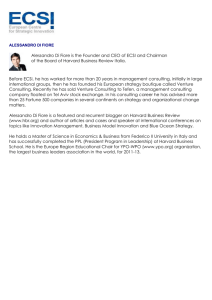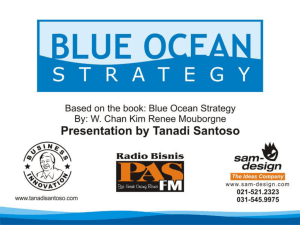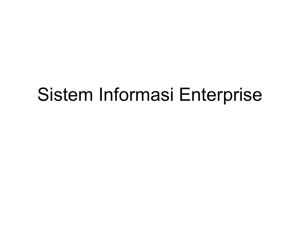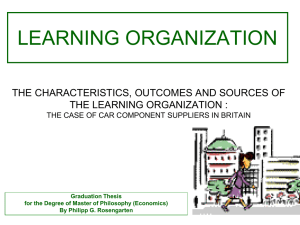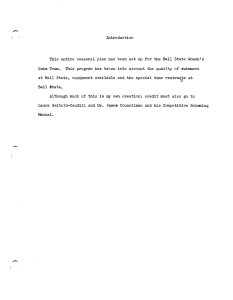m4b-neworganization
advertisement
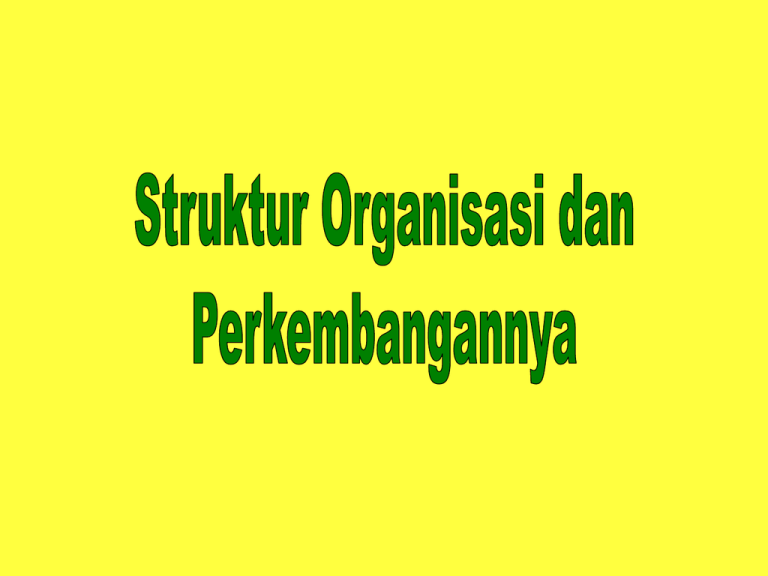
Elements of Organizations Social entities – composed of people and groups of people Goal-directed – exist for a purpose – trying to achieve an end or mission Deliberately structured activity systems – tasks are subdivided into separate departments Identifiable boundary – which elements are inside or outside of organization, distinct membership commitment in return for money, prestige or gain Organizational Structure • Organizational structure specifies the firm’s formal reporting relationships, procedures, controls, and authority and decision-making processes. • It is critical to match organizational structure to the firm’s strategy. Chandler’s comment: “Structure follows strategy” needs to be balanced with dynamic nature of strategy. The inherent tension in corporate structure • Structural stability provides the capacity – required to consistently and predictably manage the firm’s daily work routines • Structural flexibility provides the opportunity to – explore competitive possibilities – allocate resources to activities that shape competitive advantages needed by the firm ORGANISASI MEKANIK, ORGANIK DAN BIROKRATIK KOMPLEKSITAS FORMALISASI SENTRALISASI ORGANIK RENDAH RENDAH RENDAH MEKANIK TINGGI TINGGI TINGGI BIROKRATIK TINGGI TINGGI RENDAH KARAKTERISTIK BIROKRASI IDEAL DARI WEBER • • • • • • Pembagian tugas secara tegas Hierarki jelas Seleksi berdasarkan kualifikasi teknis Gaji tetap Merupakan pekerjaan utama Promosi berdasar senioritas atau prestasi dan tergantung pada penilaian atasan • Pemisahan antara pemilik dan pekerja • Aturan umum yang mengikat pegawai BERBAGAI TIPE STRUKTUR • • • • • • (1) STRUKTUR SEDERHANA (2) STRUKTUR FUNGSIONAL (3) STRUKTUR MULTIDIVIDIONAL (4) STRUKTUR MATRIKS (5) STRUKTUR HIBRIDA (6) STRUKTUR JARINGAN (NETWORK) STRUKTUR SEDERHANA • Biasanya terjadi pada organisasi yang baru dibentuk (misalnya usaha wiraswasta yang baru dimulai) atau organisasi yang memang sengaja dibuat kecil (mis. tempat praktek dokter). Tingkat diferensiasi dan kompleksitas RENDAH. STRUKTUR FUNGSIONAL • Ketika struktur sederhana tidak lagi mencukupi, ketika organisasi berkembang dengan tugas-tugas yang semakin kompleks, maka biasanya dibentuk struktur FUNGSIONAL. • Fungsi atau Tugas-tugas yang sama dikelompokkan menjadi satu. Misalnya, perusahaan manufaktur BAGAN STRUKTUR FUNGSIONAL GENERAL MANAGER PURCHASING ENGINEERING MANUFACTURING MARKETING ACC. & FIN Matching Structure and Strategy • Different forms of the functional organizational structure are matched to – cost leadership strategy – differentiation strategy • differences in these forms can be seen in important structural characteristics Structure for _________ Strategy • Operations is main focus • Process engineering is • • • Office of the President emphasized over R&D Large centralized staff Formalized procedures Structure is mechanical, job roles highly structured Engineering Centralized Staff Accounting Operations Marketing Personnel Structure for _________ Strategy President and Limited Staff R&D New Product R&D Marketing Marketing Operations Finance Human Resources • Marketing is the main function for tracking new product ideas • New product R&D is emphasized • Most functions are decentralized • Formalization is limited to foster change and promote new ideas • Overall structure is organic; job roles are less structured Strategy and Structure Growth Pattern: Simple Structure Multidivisional Structure Efficient implementation of formulated strategy Multidivisional Structure Sales GrowthCoordination and Control Problems Functional Structure Efficient implementation of formulated strategy Sales GrowthCoordination and Control Problems The importance of the m-form • Williamson (1985) wrote: “The most significant organizational innovation of the twentieth century was the development in the 1920s of the multidivisional structure." Multidivisional Structure • Each division is operated as a separate business • Appropriate for related-diversified businesses • Key task of corporate managers is exploiting synergies among divisions The example of General Motors Three Variations of the Multidivisional Structure Multidivisional Structure (M-form) Cooperative Form Competitive Form Strategic Business-Unit (SBU) Form Strategy and Structure Growth Pattern: Multidivisional Structure • Three major benefits – corporate officers able to more accurately monitor the performance of each business, which simplifies the problem of control – facilitates comparisons between divisions, which improves the resource allocation process – stimulates managers of poorly performing divisions to look for ways of improving performance Dasar Kompetisi P E R DAYA SAING OTAK ORGANISASI YANG CERDAS M I INOVASI ORGANISASI YANG INOVATIF N T A ORGANISASI YANG FLEKSIBEL PILIHAN FLEXIBLE COMPANY A N KUALITAS ORGANISASI YANG QUALITY COMPANY BERKUALITAS P A S ORGANISASI YANG EFFICIENT EFISIEN COMPANY BIAYA A R TAHUN 60-an 70-an 80-an 90-an 2000 - an Keberatan Program Rigid Business system known as Value Chain (equity link) Corporate function Network function with key levers at hand Sales Servic es Overseas Operation R&D Manuf Marke acturi ting ng R&D Kenichi Ohmae, 2000 Telco $ bill collection $ Engin eering Marke ting In Bangalore, Heyderabad The Company Manuf acturi ng In Vietnam (Outsourced) A 20th-century company Silicon Valley Custo mers internet Sales Servic es Major Markets (Outsourced) A 21st-century corporation Organisasi Hirarkis (Vertikal) Organisasi Datar/Flat (Horizontal) Proy 1 Nucleic Organization Ketua 1 Ketua 2 Proy 2 PimPro 1 PimPro 2 PimPro 3 Organisasi Matriks Organisasi Nucleic/ Inti Organisasi Hirarkis Persaingan makin ketat Perlu Organisasi makin efisien Perlu proses pengambilan keputusan makin cepat Organi sasi Pembel ajaran “The single greatest challenge facing managers in the developed countries of the world is to raise the productivity of knowledge and service workers. This challenge, which will dominate the management agenda for the next several decades, will ultimately determine the competitive performance of companies. Even more important, it will determine the very fabric of society and the quality of life in every industrialized nation… “(Drucker, 1991) Triarko Nurlambang Badan Kemitraan Ventura UI Absorption Diffusion Specialist Exploitation of knowledge from outside of knowledge within of knowledge within of knowledge in products and services • External professional networks • Education •Conferences • Customer contacts • Competitive analysis • Supplier co-operation • Acquisition • Patents and licences • Research • Knowledge management • Creative scenarios • Assembly and use of manuals • Regulations and procedure •Knowledge information system • Best Practice study • Internal knowledge exchange • Coaching and monitoring • Peer assessment • Informal networks • Job rotation • Programme and project • Concepts of final reports and product •Simulation of markets and processes • Quality reviews • Action learning • Dialogue • Self assessment • Performance measurement and rewards • Business process reengineering • Professional feedback • Cross-disciplinary project teams • Using existing knowhow for new products •Market research • Promoting knowledge (internally and externally) • Improving products based on customer reviews • Prototyping • Delivery •Breaking through learning barriers Organic Informal Generalist Innovation People Systems Programme Absorption Explicit Specialist Diffusion Specialist Continuity Exploration Model Mental Keahlian Pribadi Visi Bersama Pembelajaran Tim Peter Senge Pemikiran Sistem Personal Mystery Mental Model Shared Vision Team System Learning Thinking Essences • Being • Generativeness • Connective ness • Love of truth • Openness • Common purpose • Partnership • Collective intelligence • Alignment • Holism • Interconnectedn ess Principles • Vision • Creative / emotional tension • Sub-conscious • Espoused theory vs. in-use • Ladder of inherence •Balance inquiry and advocacy • Shared vision of individuals • Commitment, rather than compliance • Complementary dialogues and discussions • Defensive routines • Structure influences behaviour • Policy resistance • Leverage Practices • Clarifying personal vision • Holding creative tension with focus on results and seeing current reality • Making choices • Data vs abstractions from data • Testing assumptions • Left-hand column • Envisioning through sharing visions, listening and free choice • Acknowledging current reality • Suspending assumptions • Acting as colleagues • Surfacing own defensiveness • Practising • System archetypes • Simulation Konfigurasi Organisasi (Mintzberg’s Configurations) Pull to lead Strategic Top Pull to rationalize Technostructure Pull to collaborate Support staffs Middle Management Operating Core (Pull to professionalize) Sumber: ten Have, et.al, 2003 Ideology Pulling togetherness Politics Pulling apart Knowledge creation Continuous innovation Competitive advantage Beberapa contoh hasil prediksi masa depan Berdasarkan studi J.R. Mooneyham 2006 Wireless LAN 2008 Nanocomputer elements 2010 Optical cards menggantikan floppy disk 2015 Mendengarkan musik 6 hari dalam satu chip 2035 Super-jumbo jets membawa 1500 penumpang 2038 NASA mengirim orang pertama ke Mars 2050 Bertamasya ke luar angkasa 2058 Implan otak buatan meningkatkan kemampuan intelijen 2064 Otak buatan terkoneksi dengan komputer 2073 Kota bawah tanah terbangun 2087 Ekosistem di re-boot 2088 Muncul banyak spesies baru 2150 Bermunculan non-biologis yang bisa berpikir 2300 Ada kuda diangkasa 2450 Ditemukan the “United State of Earth” 2500 Pemukiman baru di Mars • Siklus Kondratieff yang menjelaskan siklus 60 tahunan atas dasar adanya perubahan radikal dalam teknologi sehingga menciptakan satu bentuk kehidupan baru • Tren ketenagakerjaan dikembangkan oleh Leo A. Nefiodow) dimana sektor pertanian akan mengalami kemunduran dan sektor jasa menjadi semakin utama • Tren teknologi yang dikembangkan oleh Gartner (Hype Cycle) dan Moore (Moore’s Lawn perkembang microelectronics; dunia menjadi terkonvergensidan siklus perubahan semakin pendek Me Inc. (Kita/pribadi merupakan ‘satu perusahaan’) Edukasi (sekolah, pelatihan, pendidikan lanjut, hobi) Keilmuan / ma’rifat (intelektual, spiritual, sosial, fisikal) Budaya (tingkat sosial, civilization, agama, dll) Visi untuk semangat, tubuh dan jiwa Kepribadian (tipe, karakter, tingkah laku, emosi) Pembelajaran terus menerus / life-long learning (profesional, privat) Konsep Hidup (semangat,tubuh, pernikahan/hubungan sosial, kehidupan seharihari, waktu luang, karir, keuangan, kepribadian, kasus khusus, Pengalaman) Hasrat dan tujuan hidup Nilai-nilai pribadi (model, idealisme,) Lingkungan sosial (standar hidup, gaya hidup, umur) ) Nilai / model kepribadian Pengetahuan (Pengalaman, keahlian, kekuatan absolut, fitur unik) Skenario hidup Catatan pretasi (sertifikat, paten, publikasi, top-class achievements) Pengalaman dan kompetensi pribadi Kehidupan/ aktifitas setiap hari Waktu Luang Karir Keluarga Analisis varian target/aktualisasi (umpan-balik, pengetahuan teknikal, perilaku sosial, citra) Hobi Kesehatan (olah raga, nutrisi, pandangan hidup) Kebisaan/ Abilities (bakat, anugerah, hobi, soft skills) Olah Raga Kebutuhan hidup (teori / Piramida Maslow) S W O T

